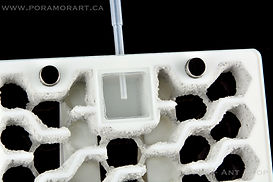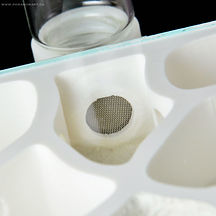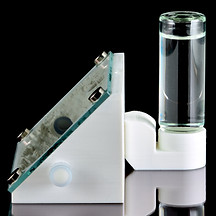Shop global, We ship worldwide.
Ant Formicarium Hydration Guide
Why is formicarium hydration so important?
Proper hydration is a vital factor for a successful ant-keeping experience. Ant formicaria require careful attention to ensure the right moisture balance to keep the colony thriving. Common mistakes in this hobby include both overwatering and underwatering ants.
This guide will explore the movement of water through the air and porous materials, explain the various hydration mechanisms, and provide guidelines for using our products.
Our formicaria are classified into; GEN 1, GEN 2, GEN 3, Evaporator module, Test tube and Naturalistic class. Their hydration varies slightly and can be combined in most instances.
Understanding Water Movement in a Formicarium:
Examining the behaviour of water and air on porous surfaces is essential to grasp how water travels within a formicarium. Here are some key factors to consider:
-
Warm air rises as it is lighter than cool air.
-
Moist air also rises as it is lighter than dry air.
-
Warm water evaporates faster than cold water.
-
Warm air can hold more water molecules than cold air.
-
Water moves from areas of high concentration to low concentration in both air and substrate.
-
The relative humidity % changes with temperature.
By understanding these principles, you can better understand the movement of water within a formicarium.
- Hydration Mechanisms:
There are two main types of hydration mechanisms: direct and indirect:
-
Direct Hydration:
Water comes into direct contact with the substrate through porous materials, which helps transport water throughout the formicarium through a process called "capillary flow" (the wicking of water through narrow spaces or pores) and "surface diffusion" (the movement of water molecules through a solid material from areas of high humidity to low humidity). Direct hydration chambers transport water more quickly into the substrate than indirect hydration chambers, and they don't rely on factors like temperature or air humidity to do so. The amount of water transported into the substrate can be controlled directly by adding more or less water as needed.
-
Indirect Hydration:
Water is not in direct contact with the substrate and must be transported through "vapour diffusion" (air carries water vapour). Water evaporates into the air and diffuses from high-humidity to low-humidity areas. This process is aided by hygroscopic materials such as porous substrates, which pull water molecules from the air, and condensation (air saturated with water vapour or a drop in temperature forces water molecules from the air). Indirect hydration chambers rely heavily on the temperature and humidity of the air inside and outside the formicarium to transport water. The changes in temperature and humidity are what we regulate to achieve the desired hydration level indirectly. Ironically, the amount of water in the hydration chamber does not affect the relative humidity. Whether it is full of water or nearly empty, it can still evaporate into the air at the same rate.
- Air humidity or substrate humidity? What is the difference?
Absolute humidity refers to the total amount of water vapour in the air. In contrast, relative humidity refers to the amount of water vapour in the air compared to the maximum amount that air can hold at a specific temperature. The temperature of air affects its capacity to hold water vapour. Hot air can hold more water than cold air. When the air reaches 100% relative humidity, it cannot hold more water vapour. If the temperature drops, water vapour will condense and precipitate on surfaces. The opposite happens if the temperature increases, making the air feel dry and reducing relative humidity.
Substrate humidity, however, refers to the amount of water in a porous material compared to the maximum amount it can hold. This depends on the size of pores and the material's molecular structure, which affects its ability to absorb and retain water. Substrate humidity is relative and measures the percentage of water in the material compared to its saturation point, where no more water can be absorbed.
It's possible to have a substrate with 75% humidity while the air around it has only 25% humidity, or the opposite - very humid air and very dry substrate. The relationship between air and substrate humidity depends on temperature and air movement.
- Let’s put all of that together:
A direct hydration chamber raises the humidity of the substrate directly, meaning water first travels throughout the substrate and then evaporates into the air inside a formicarium. The rate and amount of water the air absorbs depend on the relative humidity and temperature of both air and substrate, as well as the ventilation inside the nest, which could introduce air from outside with different humidity and temperature.
An indirect hydration chamber must first evaporate water into the air around it, and then the air will diffuse and spread inside the formicarium. The substrate will absorb more or less water from the air based on temperature, hygroscopic coefficient, and condensation. Unlike direct hydration, water transport in the air happens first, then the substrate. To move more water or speed up the process, the hydration chamber should be heated to increase evaporation. In contrast, the substrate or areas needing water should be kept at a lower temperature. This way, when the wet air reaches them, it will be forced to seem more humid and allow for absorption or condensation on the surfaces.
In a formicarium, it is common to have more water in the substrate as it can hold more water than air. The air's relative humidity depends on the temperature, and the amount of water the substrate or indirect hydration chamber evaporates. This is why water droplets can be seen on glass surfaces. The substrate absorbs the water quickly, but glass gathers the water into droplets, unable to return to the air. In either case, a wet substrate or glass indicates that the relative humidity at some point reached 100%, forcing water molecules to exit and condense, saturating the surface and appearing "wet" to us.
The mystery of formicarium hydration is due to the many factors involved, such as the direction of water transport, the destination (substrate or air, or both), the ants' need for more humid air or substrate, and the presence of temperature and humidity gradients, among others.
Contrary to popular belief, the main objective of a hydration chamber is not to provide ants with drinking water. Ants mainly acquire clean water from early morning condensation, rain, and fluids from their food sources. The substrate in their nest is hydrated mainly from rainwater that penetrates deeply. Instead, the main objective is to hydrate the air and walls. Like humans, ants need a specific relative humidity in the air and substrates, similar to how humans prefer dry clothes and beds while drinking water to stay hydrated.
Example with Camponotus species:
Camponotus ants generally don't need much humidity. If the air in your house has a relative humidity of 50% and temperatures around 24ºC, the formicarium won't need much water. Just enough to keep the substrate slightly moister than the air is sufficient. For this species, a water evaporator with no heat applied and a few drops of water every few days in the built-in direct hydration chamber of the nest is enough.
In the photo, there are two tubes arranged in an array. The top tube has water and is at room temperature, while the second tube is dry and near a heat cable. The queen and eggs are in the wet, colder tube, and the cocoons are in the dry and warmer tube. In nature, different species place the queen deep underground and the cocoons closer to the ground under a warm rock.
Hybrid Formicarium Hydration Chamber Instructions:
General notes:
-
Always use distilled water. This helps diminish mineral build-up over time.
-
At a minimum, wait at least 24 to 48 hours after the hydration chamber empties before adding more water.
-
If water droplets are present on the glass or substrate, or if it looks wet, do not add more water. Even if the water chamber is empty, too much water can cause flooding and mould outbreaks, and such excess will look for ways to escape and evaporate, leaving salts or mineral build-up behind.
-
Direct hydration chambers must only be filled to the max capacity (100%) on their first use. after initialization, only fill to a % similar or lower to the relative humidity value required by the housed species.
-
We suggest introducing ants 24 hours after the first fill to allow moisture to settle in the substrate.
-
Indirect hydration chambers such as evaporators can be filled to the max at all times as they are mainly controlled by temperature.
- GEN 1, 2 & 3 formicaria:
The three generations work with a direct hydration chamber found inside the formicarium. As explained above, direct hydration chambers can transfer lots of water and do so quickly. The substrate is contained inside a glass & plastic frame and requires very little water to stay humid. The amount of water added to the hydration chamber and the frequency determines how much water the substrate absorbs and how humid the air inside will be.
In all three generations, the goal is to create a hydration routine & schedule, for example, “1mL of distilled water every five to six days”. The temperature, ventilation and humidity around the formicarium determine how fast this water escapes. We want to add just enough to keep a balance around the moisture needed in the substrate. Water added vs water evaporated vs required humidity. It is best to offer small amounts of water periodically compared to a considerable amount every so often. The amount and frequency will differ for all users and require observation, experimentation and fine-tuning. Most users quickly learn to recognize the subtle cues, especially if the general notes in this guide are followed.
Always inspect the glass and substrate surfaces for condensation or signs of wetness. Having some minor condensation early in the mornings is typical (or with any drop in temperature), but if it is always there or it takes longer to disappear as the day warms up, you need to add less water and less often. On the contrary, if you never see condensation, even with aggressive temperature reductions, you may need to add more water or do so more often. You can DIY test how far you are from the DEW point with a tiny piece of ice or a chilled coin, place it against the glass in the area you want to test, and pay attention to the time it takes for light fog on the glass to appear on the inside, remove and pay attention how long it takes for it to re-evaporate.
If the hydration chamber is empty, does that mean the formicarium is dry?
No, water may disappear from the reservoir, but it is now stored within the nest’s walls in the porous substrate and will slowly evaporate through the plastic frame and glass. But, if left enough without water, the substrate will eventually dry out. This explains why a routine and schedule are the best for ensuring consistent humidity.
Radiant heat from above is generally preferred (heat lamp or light bulb, heat cable on the glass). It mimics the sun warming up the ground and objects like rocks. In this case, glass tends to warm up instead of the substrate, avoiding the typical condensation we get on the glass when heating from underneath with a cable or heat mat (in this case, glass is colder).
When it comes to hydration, the differences between the GENs are:
-
GEN 1: has a sealed hydration chamber, a glass is glued in place, and water can only be transported onto the substrate through the porous material next to it. This is why the honeycell, honeycell mini and classic hybrid can stand or be tilted.
-
GEN 2: has an unsealed hydration chamber directly under the glass that covers the entire formicarium. Water is mainly transported onto the substrate through the porous material, but capillarity and evaporation can also happen in the tiny gap between the glass and plastic frame.
-
GEN 3: the water chamber is sealed and enclosed in the frame (not visible). Water can only be transported onto the substrate through the porous material next to it. The hydration chambers hold less water than GEN 1 & 2 and are located at the bottom of the design under the substrate. GEN 3 relies on visual inspection of the substrate, changing from light to dark grey as humidity distributes through the inside walls. Using this gentle change in colour, you can determine when the formicarium is starting to dry again and, at such time, add a small amount of water.
- The Evaporator module:
The evaporator module uses indirect hydration. It provides water vapour through a mesh-protected tube port. The evaporator module is sensitive to heat. The hotter it is, the more water evaporates and diffuses into the formicarium air. A heating cable can be placed between the formicarium and the watering module, a heat mat under it, or a radiant source like a heat lamp can be pointed towards the glass bottle to increase the temperature in that area.
It is widespread to see formicaria with a little water reservoir covered with a metal mesh to prevent ants from directly touching water. Such is an indirect hydration mechanism relying on water evaporation. To saturate the substrate, the air must reach 100% RH to condensate onto the substrate. Refill the bottle as often as needed.
Our water evaporator module can be purchased independently and connected to any GEN 1, 2 or 3 formicarium to allow for direct hydration strategies. The curvesome formicarium revolves around this idea. This method allows controlling the relative humidity of the substrate with the direct hydration chamber and the relative humidity of air through the evaporator as needed.
- Test Tubes:
Refillable and traditional test tube setups rely on the direct hydration chamber mechanism. Water travels through the cotton and evaporates into the air inside the tube. There is little that can be done to control the relative humidity of the air inside other than changing temperature, creating a gradient with a heat source or reducing the opening at the front of the tube to reduce the amount of water that escapes.
Examples:
-
If you place the water reservoir and wet cotton on top of a heat mat or cable, such will evaporate more water. If the front of the tube is not heated, a gradient from cold to hot will form. This will result in condensation appearing on the glass as the air inside becomes humid and condenses on the cold glass surfaces.
-
If you place the heating cable on the front of the tube, such will heat the air lowering the relative humidity and increasing the amount of water that escapes through the front cotton, unless the entrance is very restricted.
-
Using a heat lamp from above or placing the heating cable above the tube on the air side near the wet cotton will prevent water from condensing on the glass and evaporate water from the back, creating a warm, moist environment.
There are many combinations, and each will fit different species depending on the humidity needs.
When do you add more water to the refillable test tubes?
Wet cotton looks different from dry cotton as it interacts with the glass. Wet cotton looks flushed as water fills the air gaps between the cotton fibres and the smooth glass surface. Dry cotton seems to separate from the glass as these air gaps reappear. In general, 1mL of water seems to last 2 to 3 weeks.
Remember, less is more…!
- Naturalistic Formicaria:
These setups usually don't have a dedicated hydration chamber. Instead, they rely on the soil mix to absorb, diffuse and retain water. In that sense, they work with a direct hydration approach. In practice, water is added through hydration ports that bring the water directly to the soil, and the colour or apparent wetness of the media is used as an indicator of how much water is needed.
It is wise to supply water slowly to avoid erosion or collapse of tunnels as water diffuses. A very dry substrate is also more prone to collapse with vibrations. Please remember that the quantity of soil or tunnelling media present directly affects how often and how much water to add a small volume of media can dry faster and requires water more often in small amounts as it can hold less water. A large volume can last longer, buffer humidity better, and hold more significant amounts of water. Materials like vermiculite, perlite or coconut fibres are often added to the mix to help with water retention and absorption.







